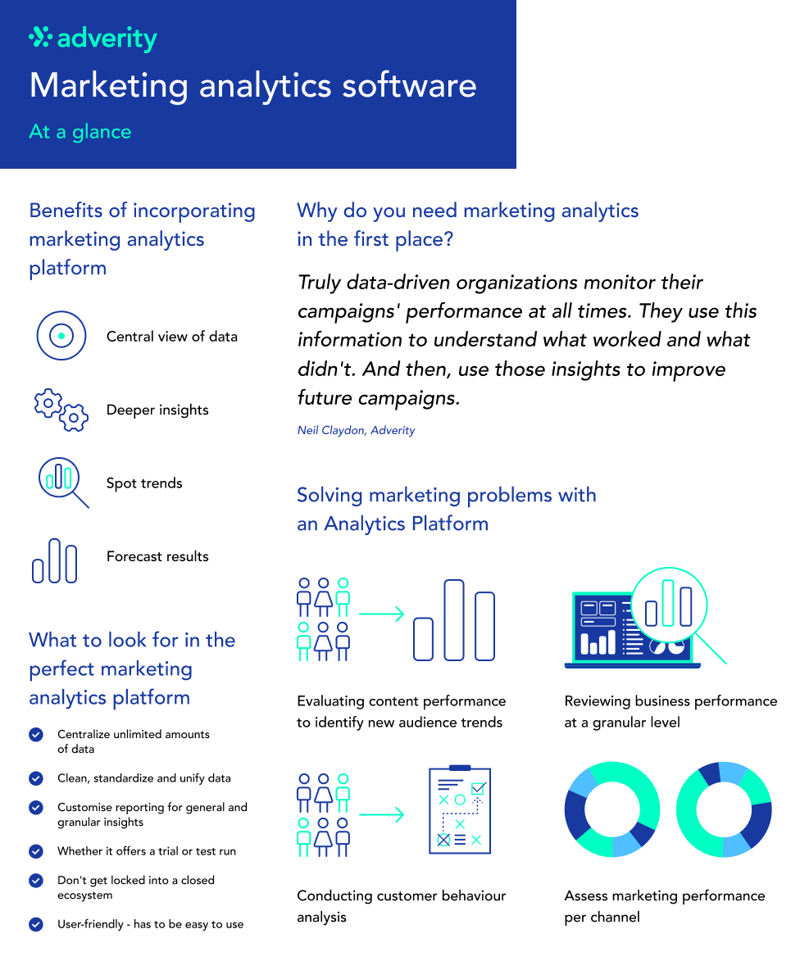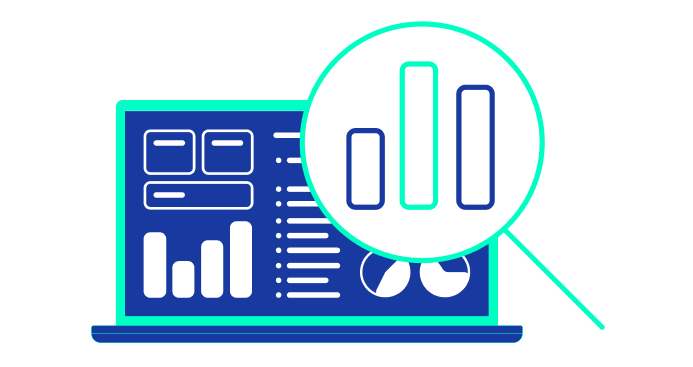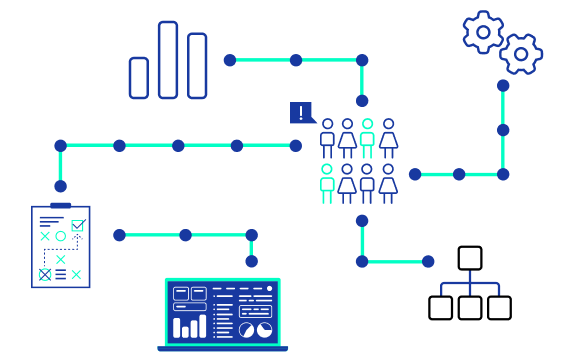How to choose the best marketing analytics software in 2023
Skyrocket your ROI and efficiency with the right tools



Can you believe the average marketer uses that many software tools in their work?
Unfortunately, the problems extend beyond the difficulties of dealing with such a large number of platforms. Trying to monitor marketing performance across so many data points is also challenging.
Manually collecting all this data and analyzing it in one central location takes an insane amount of time. Not to mention that, with different data formats, getting the full picture of a campaign’s performance would prove practically impossible.
The situation arises for one simple reason: information scattered across too many tools.
Each platform uses its own data format, style, and frameworks. You may ask: how can I bring it everything together under a unified system?
Fortunately, there is a solution. By using marketing analytics tools, users can effortlessly gather, collect, and analyze information within one central location.

On this page, you’ll gain all the information you need to select the best marketing analytics software for your business.
We’ll talk about:
“At the heart of any marketing analytics strategy should be improving ROI. Data-driven organizations can achieve this objective by monitoring their campaigns’ performance at all times. They use this information to understand what worked and what didn’t. What’s more, use those insights to improve future campaigns.”
However, it’s important to stress this again. The benefits of using the data-driven approach to marketing go far beyond just having more information at hand.
Teams incorporating data in their work achieve a much higher efficiency per campaign. They’re able to make better decisions and do it faster. Moreover, they’re then better placed to respond to customer engagement and improve campaign performance in real-time.
Marketing teams do it all by evaluating each channel’s performance to understand the big picture of their initiatives. They also fine-tune campaigns based on historical data, assess competitor’s strategies, and conduct a whole range of other research.
In short, the effective use of data helps marketers grow their business faster through a better and more focused decision-making process.
Marketing analytics software plays a crucial role in ensuring that companies truly capture the full potential of their data.

The simple truth is that many marketers aren’t fully aware of the capabilities that modern marketing analytics software.
“Is it not just about any tool I can use to access some data about my work?”
No, not really.
Next-generation marketing analytics software provides the tools and processes that allow companies to efficiently collect, organize, manage, and take control of their data. By embracing the true potential of big data, firms stand to benefit from increased operational efficiency, boost performance, and, ultimately, the company’s bottom line.
Marketing analytics software permits long-term monitoring of marketing efforts. Such insight, in turn, can help organizations to:
What’s more, with the right analytics tool, a marketer can gain valuable new insights without relying on the input from the business intelligence teams. They can access, correlate, and analyze the information available to them to gain a better understanding that can help them determine their next steps.
While this guide will later help you to choose the right marketing analytics tool for your needs, let’s first evaluate why you should consider investing in a solution.
If you want to take your marketing efforts to the next level, an analytics tool would be an invaluable addition to your marketing stack.
Here’s why.
One. Such software gives you a centralized view of all your data.
An analytics platform eliminates the burden of having to review scattered datasets that are ordinarily isolated from each other. Instead, you gain a complete picture of your campaigns in one place.
The above happens because one of the critical functions of analytics software is to collect data from all marketing channels automatically.
Two. A platform gives you the ability to gain deep insights about marketing performance.
Being able to view all the information from various sources together provides a hugely valuable opportunity to learn from past and current campaigns.
With it, you can deep dive into the data to uncover insights you would have never uncovered with dispersed information.
Three. You can monitor trends and spot new opportunities.
Today’s markets change at an incredible pace. Customers develop new expectations, which demands more attention from companies. Technological advancements and innovation open up new opportunities. However, both of these outcomes create threats to tackle.
Businesses with growth aspirations must continuously analyze their data to monitor the market, spot new trends, opportunities, and forecast challenges.
Once again, being able to do so from a single platform means a far greater chance of success.
Four, software makes forecasting upcoming results easier.
A centralized platform for your data makes it so much easier to predict potential outcomes of new marketing initiatives or campaigns.
Even a simple year-on-year analysis of marketing performance, for example, would help marketing managers forecast results for any new idea.
The benefits we’ve touched on so far are just the tip of the iceberg. Marketing analytics tools can help you overcome specific marketing challenges. We will now take a look at some of the most common ones.

We’ve already considered the reasons for implementing marketing analytics tools. Later on in this guide, I’ll show you what to look for when choosing software to collect and analyze your data. However, before we go there, let’s talk about specific use cases for a marketing analytics tool.
Because in spite of having all the data, you might still wonder whether you should use software to process it at all. So, here are just a handful of example use cases for marketing analytics software.
Bringing all data relating to your content marketing campaigns together allows you to take a holistic view of your efforts. This information helps you answer all kinds of questions relating to content performance – including whether it delivered the results expected, to gauging audience engagement levels. What’s more, assessing how people respond to your content might help you identify new trends or interests that you should focus on going forward.
Combining information about the target market with internal data from the CRM, website analytics, and sales allows you to build a complete picture of the customer behavior throughout their lifecycle.
With it, you can identify what engages them the most during the research stage, how to compel them to act, the average value of your customers and more.
With such information at your fingertips, you can fine-tune almost every aspect of your marketing and sales processes.
Consider what happens when you have to evaluate what effect a specific event – a new product launch, for example – had on business performance. You find yourself lacking the data to make this connection, right? You need a granular view at an event-level, and luckily, that’s something a data platform can efficiently deliver.
A marketing analytics tool allows you to analyze the impact of every channel you use – SEO, social media, email, advertising. In turn, you can identify its effect on your goals and business performance.
With it, you can conduct a basic analysis to determine overall performance — or a more in-depth assessment to evaluate which initiatives delivered the highest value to the company.
In short, you can use marketing analytics software to review your efforts, draw conclusions based on the data, and use that insight to improve your work moving forward.
Crucially, you can do it all without relying on someone else to export the data, analyze it and forward their findings to you.
The above, in turn, makes you:
However, there is still a problem we haven’t addressed yet.
With so many tools on the market, how do you know which tool is best for you? What functionality do you require? What capabilities should your chosen tool have available out-of-the-box?
Now, let’s start answering some of those questions!
Marketing analytics software packages come in various shapes and sizes. A robust marketing analytics tool should provide the following capabilities:

Given its purpose, the tool should pose no restrictions regarding how much data or data sources you can import and process.
Without it, you may find yourself struggling to derive insights, as the volume of data you need to process continues to grow.
Most of your data would come from dispersed sources. Before attempting to analyze your data, you must ensure that the platform you use allows you to harmonize data from all the sources you collect from. This requires blending data formats, naming conventions, labels, and so on into a unified dataset. Your platform, therefore, should offer a way to transform and map information using predefined templates.
Without this, you’ll struggle to extract insights from disparate data.
In the charts above, you can see that the harmonized data includes various cost metrics. Inconsistent naming conventions between different platforms have resulted in unmapped cost data. The Y-axis may state that the currency is Swiss Francs, though it’s possible that the dataset includes other currencies as well.
By contrast, the visualization using harmonized data provides a single cost metric as the data formats and naming conventions are now consistent. Despite including data from multiple sources, this visualization provides a reliable and holistic representation of costs.
Adverity transforms your data automatically – requiring no manual manipulation from data analysts. As a result, it’s possible to acquire a comprehensive overview of cross-channel and cross-country performance.
Data exploration is the primary reason for using a marketing analytics tool. Consequently, your tool must offer you the ability to produce custom dashboards to display the data you need to solve a particular problem.
Let’s be honest here. Purchasing a marketing analytics product is a serious investment. Even if not in terms of money, deciding which tool to use is far from easy.
When evaluating different platforms, pay attention to who provides the option to test drive their system. Crucially, you should be allowed to import your data to assess the merits of the platform based on information pertinent to your company’s operations.
Your marketing needs will, most likely, change. So will your MarTech stack. The platform you choose shouldn’t be locking you into any specific environment. You should be able to use it together with any other platform or software environment.
From our experience with dozens of clients, many organizations have a wide variety of tools in operation – and wish to stick to their established processes. Making sure that new software fits into the existing infrastructure, therefore, seems like a no-brainer. As organizations change over time, it makes sense to choose a future-proof product that does not create another silo but plays along with the rest of your tools.
Data harmonization, unification, and mapping are complex processes. Therefore, it helps if the platform offers templates for processing the most common tasks. It’s a simple thing, but it helps you uncover the insights much faster and with fewer hurdles.
Finally, we’ve suggested some questions you should ask during your evaluation process to help you identify which tool would be best suited for your needs.
Nico is the Content Marketing Manager here at Adverity and his goal is to create compelling, creative and quality content to tell Adverity’s story. He is a passionate digital marketer, but also loves to produce music, DJ and travel. You can also catch him busting out some moves at the skatepark.